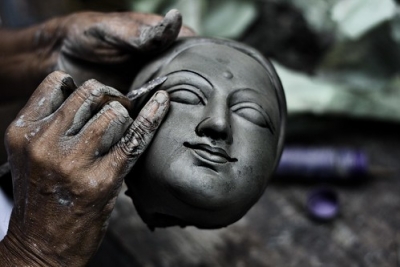Where clay shapes their livelihood?

Set in the narrow backstreets of Kolkata is a veritable mini city of beautifully sculpted idols of Hindu gods and goddesses. This is Kumartuli, the abode of potters or kumbhars. A 130-year old colony spread across five acres of land, Kumartuli has hundreds of dwellings. Each house has a high-ceilinged temporary room roofed with tin and teeming with clay idols.
The place comes especially alive during Bengal’s Durga Puja and Saraswati Puja but idols are made and sent all over India and for every important festival. Idols are even sculpted for museums and art galleries.
The work begins in mid-April after the Kathamo puja or inaugural worship followed by the ritual worship of the bamboo frames on which the idols will be cast. Clay dug out from the bed of the River Ganga is kneaded and pounded to the right consistency. The clay is mixed with rice husk and multiple layers are applied all over the frame which is idol-shaped and covered with straw. The frame is dried completely in the sun. Layers of a different fine-grained clay are then applied to give a smooth and rounded finish to the idol.
The statutes are then painted in vibrant colours by an experience artist. Finally, the idols are dressed in fine silk saris and elaborate jewels, with wigs of nylon hair and false eyelashes. A single, life-sized sculpture usually takes a week and several people’s labour to complete.
There are more than 450 workshops owned by families of master sculptors who have been creating festival idols and models of museums and galleries for generations. It is said that each year, Kumartuli produces more than 4,000 sets of idols of Durga along with her entire family.
Picture Credit : Google
